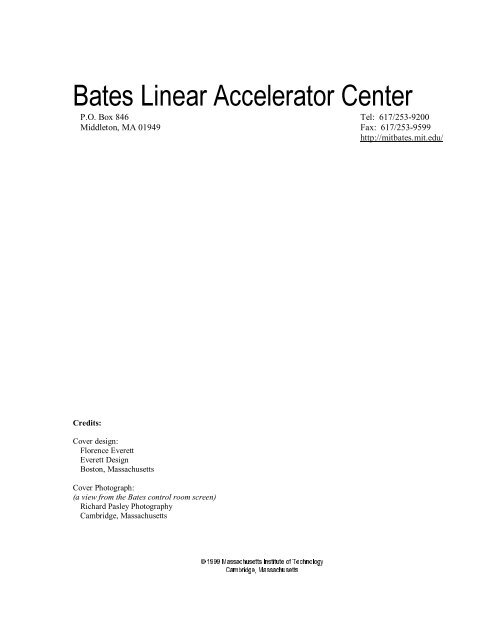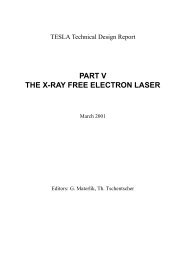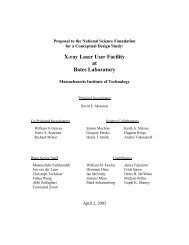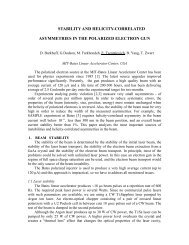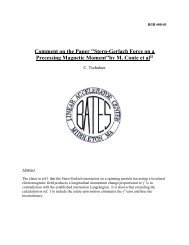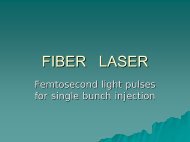Bates Linear Accelerator Center - MIT
Bates Linear Accelerator Center - MIT
Bates Linear Accelerator Center - MIT
Create successful ePaper yourself
Turn your PDF publications into a flip-book with our unique Google optimized e-Paper software.
%DWHV /LQHDU $FFHOHUDWRU &HQWHU<br />
P.O. Box 846 Tel: 617/253-9200<br />
Middleton, MA 01949 Fax: 617/253-9599<br />
http://mitbates.mit.edu/<br />
Credits:<br />
Cover design:<br />
Florence Everett<br />
Everett Design<br />
Boston, Massachusetts<br />
Cover Photograph:<br />
(a view from the <strong>Bates</strong> control room screen)<br />
Richard Pasley Photography<br />
Cambridge, Massachusetts<br />
ÃÃÃÃÃ<br />
Ã
à <br />
Table of Contents<br />
1999 <strong>Bates</strong> Report<br />
Page<br />
Introduction....................................................................................................................................1-3<br />
<strong>Bates</strong> 25 Symposium ......................................................................................................................1-5<br />
US Energy Secretary Bill Richardson’s Visit to <strong>Bates</strong>......................................................................1-6<br />
Milestones....................................................................................................................................1-13<br />
à ÃÃ<br />
Measurement of the Elastic Magnetic Form Factor and the Threshold Breakup of 3 He at High<br />
Momentum Transfers .....................................................................................................................2-1<br />
The OOPS Experimental Program ..................................................................................................2-9<br />
Measurement of the Weak Magnetic Moment of the Proton (SAMPLE)........................................2-31<br />
Overview of the BLAST Scientific Program.................................................................................2-39<br />
The CastScan Research Project.....................................................................................................2-43<br />
à Ã<br />
Overview........................................................................................................................................3-1<br />
South Hall ......................................................................................................................................3-1<br />
North Hall ......................................................................................................................................3-5<br />
Computing/Data Acquisition ..........................................................................................................3-5<br />
Status of the BLAST Project...........................................................................................................3-7<br />
à Ã<br />
Overview...................................................................................................................................... 4-1<br />
<strong>Accelerator</strong> Operations................................................................................................................. 4-1<br />
Polarized Injector ......................................................................................................................... 4-3<br />
<strong>Accelerator</strong> and Recirculator........................................................................................................ 4-9<br />
South Hall Ring.......................................................................................................................... 4-10<br />
RF Systems ................................................................................................................................ 4-15<br />
Controls and Instrumentation..................................................................................................... 4-17<br />
à ÃÃ<br />
Tours ............................................................................................................................................ 5-1<br />
Open House.................................................................................................................................. 5-1<br />
Other Programs ............................................................................................................................ 5-1<br />
Ph.D. Degrees Granted Based on Data Taken at <strong>Bates</strong> ...........................................................................5-3<br />
<strong>MIT</strong>-<strong>Bates</strong> Ph.D.s ..................................................................................................................................5-5<br />
iii
1999 <strong>Bates</strong> Report<br />
à <br />
iv<br />
Table of Contents (cont.)<br />
Page<br />
<strong>Bates</strong> Personnel.............................................................................................................................6-1<br />
Program Advisory Committee......................................................................................................6-2<br />
Approved Experiments .................................................................................................................6-3<br />
Users Group..................................................................................................................................6-4<br />
Users on Currently Approved Experiments..................................................................................6-5<br />
User Institutions on Currently Approved Experiments ................................................................6-7<br />
Publications and Reports ..............................................................................................................6-9
Section 1<br />
Introduction
1999 <strong>Bates</strong> Report<br />
This report summarizes the scientific and technical progress at the <strong>Bates</strong> Laboratory over the last<br />
year. It has been a productive period during which data taking on the SAMPLE/hydrogen experiment has<br />
been completed; substantial progress on beam development from the South Hall Ring (SHR) has been<br />
realized; assembly of the OOPS spectrometer system has been largely completed; construction of the<br />
BLAST spectrometer has made substantial progress; and production data taking on SAMPLE/deuterium<br />
is well underway as we go to press.<br />
Following the substantial investment by the Laboratory in the SAMPLE experiment over several<br />
years, it is gratifying to see the high quality data produced by this experiment. The combined data set on<br />
hydrogen and deuterium will provide unique information on the strange quark contribution to the proton’s<br />
magnetism. It will be important for future work worldwide in this area of research.<br />
A significant milestone in the utilization of the stored beam capability with the SHR was reached<br />
last fall with the measurement of elastic scattering from an internal hydrogen gas target at 660 MeV by<br />
the BLAST collaboration. Subsequent development yielded over 200 mA of stored beam. The stored<br />
beam characteristics have been found to be excellent for experiments with internal gas targets. The<br />
lifetimes in the presence of target gas have been determined to be consistent with theoretical expectation.<br />
In the next year we look forward to installation of the Siberian Snake system and the development of<br />
stored, polarized beams.<br />
In February 1999, 8 µA of high duty factor, extracted beam was directed to the B-Line and the<br />
first coincidence (e,e’p) measurement carried out by the OOPS collaboration. During this period<br />
important information on the stability of the beam, the shielding necessary in the South Hall, and the<br />
radiation levels generated was obtained. Further, a scheme to measure the extracted beam position<br />
to ± 0.5 mm has been successfully developed. Next year the first experiment using high duty factor beam<br />
from the South Hall Ring is planned.<br />
With the anticipated completion of the SAMPLE experiments in the next several months, the<br />
Polarized Source Group will have the opportunity to focus on development of polarized beam capability.<br />
A polarized source test bench should be completed in fall 1999, and the group will study strained GaAs<br />
cathodes as well as high power laser systems. These are necessary for optimal utilization of polarized<br />
beams from the South Hall Ring in the coming years.<br />
In the past year the OOPS spectrometer system has been assembled for the first time. This unique<br />
and impressive instrumentation will be utilized in 2000 for important measurements on proton and<br />
deuteron structure. At this time the OOPS collaboration is active in preparing the B-Line and associated<br />
instrumentation for this extended running period.<br />
Over the last year, the BLAST collaboration has made substantial progress. Their efforts in<br />
summer 1998 were essential in the successful operation of the polarized internal gas target and<br />
subsequent studies using stored beam. All branches have made substantial progress with many prototypes<br />
now in operation. The complete set of coils has arrived at <strong>Bates</strong>, and it is planned that the toroidal<br />
spectrometer will be installed by the end of the year.<br />
A major highlight of the past year was the visit of Energy Secretary Bill Richardson, on April 13,<br />
1999. While his clear support of the Laboratory was evident from his action concerning <strong>Bates</strong> and the<br />
FY2000 budget process in early February, the Secretary’s visit was a great honor and provided a<br />
memorable day for the Laboratory and its Users. In addition, we were greatly honored by the presence of<br />
1-3
1999 <strong>Bates</strong> Report<br />
Congressman John Tierney. On pages 1-6 through 1-12 you will find some photographic highlights of<br />
this exciting day.<br />
In closing, it is important to note that 1999 is a special year for the <strong>Bates</strong> Laboratory. It marks 25<br />
years of beam delivery to experiments in the pursuit of the scientific frontiers and in the education and<br />
training of young physicists. On November 3-5, 1999, a celebration of the past 25 years will be held at<br />
<strong>MIT</strong> and at <strong>Bates</strong>. I look forward to seeing you there.<br />
1-4<br />
Richard Milner<br />
August 1999<br />
Middleton, Massachusetts
"Celebrating 25 Years of Beam to Experiment"<br />
<strong>Bates</strong>25 Symposium<br />
November 3-5, 1999<br />
<strong>MIT</strong> Bartos Theatre<br />
http://mitbates.mit.edu/bates25/<br />
Confirmed Speakers<br />
Doug Beck, University of Illinois<br />
Elizabeth Beise, University of Maryland<br />
Aron Bernstein, <strong>MIT</strong><br />
William Bertozzi, <strong>MIT</strong><br />
Kees de Jager, Jefferson Laboratory<br />
J. L. Friar, Los Alamos National Laboratory<br />
Haiyan Gao, <strong>MIT</strong><br />
Michel Garçon, CEA/Saclay, France<br />
Donald Geesaman, Argonne National Laboratory<br />
Jochen Heisenberg, University of New Hampshire<br />
Barry Holstein, University of Massachusetts<br />
Richard Milner, <strong>MIT</strong><br />
John Negele, <strong>MIT</strong><br />
Vijay Pandharipande, University of Illinois<br />
Costas Papanicolas, IASA, Athens, Greece<br />
Gerald Peterson, University of Massachusetts<br />
Michael J. Ramsey-Musolf, University of Connecticut<br />
Robert Redwine, <strong>MIT</strong><br />
Hartmut Schmieden, Institut für Kernphysik, Mainz, Germany<br />
Ingo Sick, University of Basel, Switzerland<br />
Paul Souder, Syracuse University<br />
J. F. J. van den Brand, Free University, Amsterdam, the Netherlands<br />
J. W. Van Orden, Jefferson Laboratory<br />
Thomas Walcher, Institut für Kernphysik, Mainz, Germany<br />
1999 <strong>Bates</strong> Report<br />
This year is the 25th anniversary of the first nuclear physics experiments at <strong>Bates</strong>: photopion<br />
production in the 14° area. The first high resolution electron scattering measurements with ELSSY were<br />
made a year later. To mark this occasion we are planning two major components:<br />
1) Two receptions: a reception at the <strong>MIT</strong> Museum on Wednesday, November 3 and a reception<br />
and tour of the <strong>Bates</strong> Facility on Friday, November 5. Following the <strong>Bates</strong> reception there will be a<br />
dinner dance at the Sheraton Ferncroft, Danvers. We hope to renew old friendships with employees of<br />
<strong>Bates</strong> both current and retired, as well as with scientific colleagues -- former students, post docs and<br />
collaborators.<br />
2) A scientific symposium is planned for November 3-5, 1999. The goals of the symposium are<br />
to review the progress in electro-nuclear physics, <strong>Bates</strong>' contributions to nuclear physics and points to the<br />
future.<br />
1-5
1999 <strong>Bates</strong> Report<br />
ÃÃÃÃÃÃÃ<br />
U.S. Energy Secretary Bill Richardson visited the <strong>MIT</strong> <strong>Bates</strong> <strong>Linear</strong> <strong>Accelerator</strong> <strong>Center</strong> on<br />
Tuesday, April 13. Upon his arrival, Secretary Richardson met briefly with <strong>MIT</strong> Dean of Science Robert<br />
Birgeneau, Director of the Laboratory for Nuclear Science Robert Redwine, <strong>Bates</strong> Director Richard<br />
Milner, Associate Director Christoph Tschalaer, and U.S. Congressman John Tierney (D-Salem).<br />
Secretary Richardson then met with Ricardo Alarcon (Arizona State University); Douglas Beck<br />
(University of Illinois); Elizabeth Beise (University of Maryland); Jacob Flanz (Mass General Hospital);<br />
William Hersman (University of New Hampshire); June Matthews (<strong>MIT</strong>); Costas Papanicolas (IASA,<br />
University of Athens); Gerald Peterson (University of Massachusetts); Wade Sapp (American Science &<br />
Engineering); and Adam Sarty (Florida State University). During these discussions the Secretary heard<br />
directly why <strong>Bates</strong> is important to these experimenters and to their careers.<br />
1-6<br />
(l to r) Bill Richardson, John Tierney, Richard Milner, Patrick Dreher, Ricardo Alarcon, and Robert Redwine<br />
(Photo by S. Sobczynski)
Touring the facility.<br />
(l to r) Richard Milner, Bill Richardson, Robin Staffin, Christoph Tschalaer, and Fabio Casagrande<br />
(Photo by S. Sobczynski)<br />
1999 <strong>Bates</strong> Report<br />
Ricardo Alarcon (r) explains the BLAST project in the South Hall.<br />
(l to r) Robin Staffin, Richard Milner, John Tierney, Bill Richardson, Robert Birgeneau (Photo by S. Sobczynski)<br />
1-7
1999 <strong>Bates</strong> Report<br />
1-8<br />
At the SAMPLE experiment in the North Hall Damon Spayde explains current research.<br />
(l to r) Damon Spayde, Robert Carr, Bill Richardson, John Tierney (Photo by S. Sobczynski)<br />
Pushing the button at the OOPS gantry. Richardson and Tierney activate the 120 ton OOPS gantry .<br />
(l to r) John Tierney, Bill Richardson, Adam Sarty (Photo by S. Sobczynski)
1999 <strong>Bates</strong> Report<br />
In the South Experimental Hall, the Secretary addressed the <strong>Bates</strong> employees and assured them of<br />
his commitment to <strong>Bates</strong>. He also stated that the budgetary amendment was officially approved by the<br />
Office of Management and Budget the Monday before his visit.<br />
Secretary Richardson addressing the <strong>Bates</strong> employees.<br />
(Photo by S. Sobczynski)<br />
1-9
1999 <strong>Bates</strong> Report<br />
The Peter T. Demos Award for 1998 was awarded to Xiaodong Jiang who received the Ph.D.<br />
from the University of Massachusetts (supervisor Prof. Gerald Peterson) and the BS from the University<br />
of Science and Technology of China.<br />
The Demos Award is given in recognition of outstanding contributions that Peter T. Demos<br />
exhibited for more than three decades as an inspiring teacher, dedicated accelerator builder and laboratory<br />
director, and as a pioneer in electromagnetic research. The <strong>Bates</strong> <strong>Linear</strong> <strong>Accelerator</strong> <strong>Center</strong> Users Group<br />
established this annual award to be given to the graduate student whose progress in research at the <strong>MIT</strong>-<br />
<strong>Bates</strong> Laboratory best exemplifies the spirit, persistence and intellectual qualities that Peter T. Demos<br />
demonstrated in directing and developing the <strong>Linear</strong> <strong>Accelerator</strong> <strong>Center</strong>.<br />
1-10<br />
(l to r) Peter Demos, Richard Milner, Jochen Heisenberg, Bill Richardson, Aron Bernstein, Xiaodong Jiang, John<br />
Tierney(partially hidden), Gerald Peterson and William Turchinetz. (Photo by S. Sobczynski)
1999 <strong>Bates</strong> Report<br />
This November the <strong>Bates</strong> Laboratory will celebrate "25 Years of Beam to Experiment" with a<br />
scientific symposium and celebrations. Secretary Richardson honored the achievements of many of the<br />
<strong>Bates</strong> experimenters.<br />
(l to r) Peter Demos, Raymond <strong>Bates</strong> (brother of former Congressman William <strong>Bates</strong> for whom <strong>Bates</strong> is named), William<br />
Turchinetz, June Matthews, Jochen Heisenberg, William Bertozzi, Aron Bernstein (partially hidden), Toby Smith, Claude<br />
Williamson (partially hidden), Robert Redwine, Gerald Peterson, Anne MacInnis, and Chris Vidal. (Photo by S. Sobczynski)<br />
1-11
1999 <strong>Bates</strong> Report<br />
1-12<br />
Secretary Richardson’s visit ended with a meeting with many local officials.<br />
(l-r) Mark Kelly, Nancy Jones, Ira Singer, Bill Richardson, and John Tierney. (Photo by S. Sobczynski)
Calendar<br />
Year Milestones<br />
1964 Proposal to AEC for 500 MeV Linac.<br />
1966 Funding of 400 MeV Linac authorized (December 1966).<br />
1999 <strong>Bates</strong> Report<br />
1967 1. Middleton site acquired.<br />
2. Start of construction authorized by AEC-New York Operations Office (April<br />
1967).<br />
3. Begin building construction (September 1967);<br />
Beam switchyard design; center line waveguide design (to cope with beam<br />
divergence problem demonstrated at SLAC).<br />
4. Let contract for transmitters (Energy Systems, Inc.); Contract for accelerator RF<br />
peripherals (SLAC).<br />
5. Make decision to limit experimental program to electron scattering.<br />
1968 1. Let contract for accelerator waveguide (Varian).<br />
2. Begin design details energy loss spectrometer, ELSSY.<br />
3. Begin design details and specify water, vacuum, electrical systems design.<br />
4. Pursue Litton switchtube difficulty and design change requirements.<br />
1969 1. Building occupied. Begin utilities, vacuum, water systems installation.<br />
2. Complete injector design and initial testing - <strong>MIT</strong> campus.<br />
1970 1. <strong>Accelerator</strong> waveguide construction completed and delivered to site; begin<br />
accelerator assembly.<br />
2. Prototype transmitter completed, delivered to site, assembled for acceptance<br />
testing.<br />
3. Let contract for energy loss spectrometer work.<br />
4. Demonstrated pre-injector pulsed beam performance (440 keV, 4000+ pps, 50mA<br />
peak, 20 µsec.).<br />
1971 1. Transmitter prototype accepted.<br />
2. Begin assembly balance of transmitters; begin installation of beam switchyard.<br />
3. Let spectrometer hardware and power supply contracts (Lukens, Grumman, Bath<br />
Iron Works, Alpha).<br />
4. Demonstrate injector 7.5 MeV beam and 100 MeV accelerated beam.<br />
1972 1. Complete assembly of full linear accelerator centerline; mechanical, electrical<br />
assembly of RF transmitters; implementation of basic control system.<br />
2. Complete basic beam transport system to straight-through, 14°, and Spectrometer<br />
Room beam ports.<br />
3. Spectrometer power supply delivered and assembled.<br />
4. Demonstrate 126 MeV accelerated beam (∆ p/p = 0.2% for 80% of beam).<br />
5. Formal establishment of User's Organization (first Chair, H. Crannell).<br />
1973 1. Demonstrate 1% RF 48 hour endurance operation (170 MeV, 3 transmitter<br />
operation).<br />
2. <strong>Accelerator</strong> brought to 400 MeV capability in preparation for January 1974<br />
demonstration.<br />
3. 14° beam line implemented and installed first phase γπ experiment.<br />
1-13
1999 <strong>Bates</strong> Report<br />
1-14<br />
1973<br />
(cont.)<br />
4. Carried through horizontal assembly of energy loss high resolution spectrometer<br />
magnet and performed magnetic measurements.<br />
5. Installation underway of spectrometer peripherals, electrical, water, vacuum<br />
systems: spectrometer carriage, focal plane array, target chamber, remaining<br />
vacuum systems, etc., under construction.<br />
6. Dual PDP 11/45 computer data analysis system acquisition initiated.<br />
1974 1. Brief, low duty ratio run of full accelerator, 5 transmitters, 406 MeV: ~ 1 µA beam<br />
current to 14° area.<br />
2. Vertical assembly of high resolution spectrometer completed.<br />
3. 100 hours of ~ 1 µA beam at 125 to 200 MeV energy delivered to first phase γπ<br />
experiment.<br />
1975 1. High resolution spectrometer operating in the "energy loss" mode achieved an<br />
unprecedented 1.1 x 10 -4 resolution.<br />
2. First 16 0(γ,π) data obtained.<br />
1976 1. Development of vertical drift chambers for the electron spectrometer completed.<br />
The new system represented a major advance in the instrumentation of<br />
spectrometer focal plane systems.<br />
2. Construction completed on a fixed angle magnetic spectrometer in the 14° area for<br />
the study of the (γ,π ± ) reaction.<br />
1977 1. 180° scattering facility installed and used for physics experiments.<br />
2. Expansion of laboratory facilities authorized.<br />
3. Fixed angle 250 MeV π 0 detector for experiments in the 14° area.<br />
1978 1. Large diameter beam dumping system installed at the high resolution electron<br />
scattering facility.<br />
1979 1. South Hall and new buildings completed.<br />
2. Authorization received to construct a beam recirculator to increase maximum<br />
beam energy from 410 MeV to 750 MeV.<br />
3. Authorization received by Yale to design and build the polarized source for <strong>Bates</strong>.<br />
1980 1. First electron beam into the South Hall.<br />
1981 1. Opening angle π 0 spectrometer operational and taking data.<br />
1982 1. Successful operation of the recirculator.<br />
2. Completion of construction of the One Hundred Inch Proton Spectrometer<br />
(OHIPS) and the Medium Energy Pion Spectrometer (MEPS).<br />
3. First electron scattering and pion production experiments in the South Hall.<br />
4. Detailed design of BigBite Spectrometer started.<br />
1983 1. Fabrication and installation of sixth RF transmitter begun. Rework of modulators 2<br />
through 5 started. These projects increased maximum energy to 1060 MeV.<br />
2. Extension of utility building begun.<br />
3. First (e,e'p) experiment.<br />
1984 1. Polarized source moved from Yale to <strong>Bates</strong> for completion.<br />
2. TIRUS, a <strong>Bates</strong>-developed very high speed readout system, installed on MEPS.<br />
1985 1. Completion of construction of the BigBite Spectrometer.
1986 1. Completion of electron scattering experiments on tritium.<br />
2. Delivery of polarized electrons for experiments.<br />
3. High intensity pure photon beams available on Beam Line C.<br />
1999 <strong>Bates</strong> Report<br />
1987 1. Deuteron tensor polarization experiment, 2 H(e,e’d), with a high power liquid<br />
deuterium target.<br />
2. Initiation of advanced accelerator R&D for a pulse stretcher ring.<br />
1988 1. Begin construction of the South Hall Ring (SHR).<br />
2. ÃÃÃ ÃÃÃ<br />
3. Completion of the 12 C Parity Violation Experiment.<br />
1989 1. Begin construction of first generation out-of-plane magnetic spectrometer system.<br />
1990 1. First measurements of quasi-elastic spin response: 3 He(e,e’).<br />
2. First measurement using out-of-plane spectrometer system to obtain longitudinaltransverse<br />
interference response functions.<br />
3. Record high energy for an experiment (903 MeV), record high momentum transfer<br />
(42/fm 2 ), record low cross-section measurement (5 x 10 -40 cm 2 /sr/MeV) for<br />
deuterium electrodisintegration at threshold.<br />
1991 1. First measurement of fifth response function ( 12 C + deuteron), using polarized<br />
electrons and the out-of-plane spectrometer.<br />
2. Measurement of neutron charge form factor, via spin transfer to the neutron, using<br />
the neutron polarimeter.<br />
1992 1. Beam successfully injected into the new Injection Line and transported through<br />
the West Straight Section of the SHR.<br />
1993 1. Beam stored in SHR on first day of storage commissioning. Operation with fullturn<br />
injection of 40 mA (design maximum) demonstrated.<br />
2. Focal-plane proton polarimeter installed in OHIPS.<br />
3. Energy compression system commissioned; factor of ten easily obtained.<br />
1994 1. Demonstrated resonant extraction from SHR.<br />
2. Began major upgrade program for linac and recirculator.<br />
1995 1. SAMPLE experiment takes first data.<br />
1996 1. BLAST funding approved.<br />
2. OOPS satellite supports commissioned. OHIPS reconfigured as electron detector.<br />
3. First (e,e’p) experiment with Out of Plane system.<br />
1997 1. BLAST construction begins.<br />
2. Measurement of 3 He magnetic form-factor to high momentum transfer.<br />
3. Ring commissioning demonstrates 5-minute lifetime of 60 mA stored current at<br />
750 MeV.<br />
4. High intensity and quality SAMPLE beam developed.<br />
1998 1. Measurement of N →∆ transition with OOPS in both π 0 and π + channels.<br />
2. SAMPLE data taking on Hydrogen.<br />
3. First stored beam in SHR on Internal Target.<br />
1999 1. >215 mA of stored beam at 660 MeV in SHR.<br />
2. First 12 C (e,e’p) measurement with high duty factor extracted beam from SHR.<br />
3. SAMPLE data taking on deuterium.<br />
1-15


